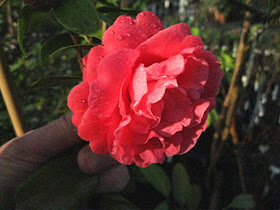I spent most of the day depressed by this post on
Garden Rant. When I looked again in the evening, I felt a little better; the comments seemed to have reached a nadir, then slowly arced towards the sane or reasonable. Is there a significant difference between a species being driven to extinction or only to the brink of extinction? Aren't we just splitting hairs?
There have been tree-like plants on this planet for almost 400 million years, insects appear somewhere around that time. For the duration of history, that is to present times, plants and insects, then other animals, as they appeared, have coevolved in a complicated, entwined, convoluted dance. The species that exist, the subspecies, are delicately tuned, finely connected in a web of interdependent relationships that we've only begun to explore. The reason organisms are beautiful, fascinating, complex is because they had to be to fit into the fabric of life.
I'm a gardener, not because I like huge peonies, or lilacs, lilies, or roses, (which I do), or because I want to grow my own food, which I do, but because I, selfishly, want to cultivate those fascinatingly complex and beautiful products of half a billion years of evolution. I want to spend every hour of every day of every year watching and absorbing the intricacy that is life. The plants in my garden come from Australia, Africa, Asia, Europe, and both Americas. The insects that fertilize and or feed on my plants are as beautiful and as interesting as the plants.
When I listen to arguments "against nativism" I smell sophisty and demagoguery. I'm not a "nativst"; I'm a "plantist" or maybe an "ecosystemist". I realize eradication is futile and a great waste of resources but at the same time it seems like we ought to work to preserve functional remnants of ecosystems. Maybe that means being a little bit careful about what we plant where. To do that we have to be honest about the behavior of all plants and animals. Our native White-tailed deer is more destructive than the worst "invasive non-native". Let's be honest about the effects of that small handful of plants that do do tremendous harm to sites that are already stressed by other factors. This is where I take issue with
There is no "Science" in upper case that speaks for whole disciplines. There are only scientists who make observations, ask questions, devise experiments, draw conclusions, and make theories. From there on, it's up to us. We have to decide which conclusions we accept and relate those abstract concepts to reality. I haven't read
How the Government got in Your Backyard (I look forward to it), but it seems a bit misleading to emphasize the fact that no non-native plant has ever driven a native plant to extinction and deemphasize the fact that an few enthusiastic handful have helped push many to the brink.
I read and reread Peter de Tredici's book and flirted with the idea of rebutting his contention, implicit and explicit, that there are no invasive plants that seriously affect unaltered environments, but refrained. I suspect he intentionally excluded the southeast from his book. Otherwise how do you respond to tens of thousands of acres of Ligustrum overrunning everything, Kudzu,
Lonicera japonica? Of course he glosses over the effect of Norway Maples in the northern Appalachians and
Hedera helix in the mid-Atlantic.
I guess I just love the world the way we inherited it. I know change is inevitable and it's the way of evolution, but it's hard to see so much biological diversity disappearing in my own lifetime.

















